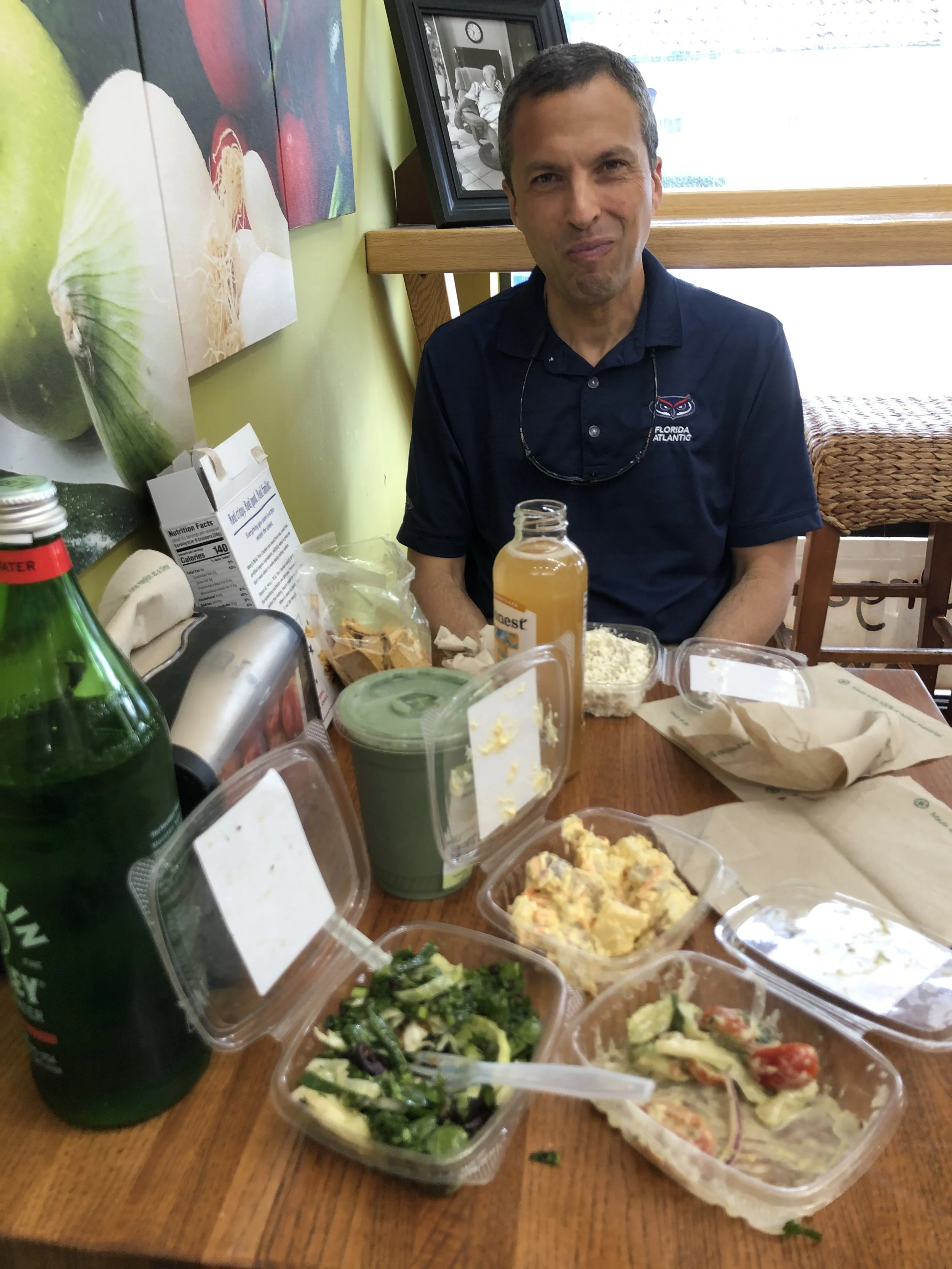Eating Out Healthy
WHAT DO WE EAT WHEN WE are away from home
Eating out at an organic cafe by our home.
There is no doubt we are much happier eating at home these days. It may not be as much fun, but it is simpler and better for our health. In fact, when we do eat away from home, we often notice slight differences in our sleep, bowel movements, and overall energy. However, there are times when we are traveling, going to a family gathering, or just don’t feel like cooking at home. So what do we eat?
GATHERING WITH OTHERS
In the Bible, food represents fun, fellowship, and nourishment both physically and relationally. The dinner table should be a place of coming together without stress or hostility with food. I have had to learn important lessons around this concept. For over 20 years, I was passionate about teaching others to eat well, to remove junk food from their diet, and to load up their bodies with fruits and vegetables — all good and necessary lessons for good health. However, my experiences have taught me that there is also a benefit to letting down your guard a little and enjoying life (food) with family and friends. I had to learn not only to relax and enjoy mealtime fellowship but also to stop imposing my view of food on others. Even though my intentions were good in wanting others to be healthy, there is a time and place for education and a time and place for relaxation, fun, and food. Ecclesiastes 5:18, “Behold, what I have seen to be good and fitting is to eat and drink and find enjoyment in all the toil with which one toils under the sun the few days of his life that God has given him, for this is his lot.”
So, it is now up to me to enjoy fellowship time with food while still doing what is best for my body and health. I can eat well without making a meal all about me and my food restrictions. Obviously, I need to be flexible (make small compromises) when traveling or eating with a group, but I can still make choices about whether or not to consume food based on how it will affect my body. Those choices do not prevent me from being socially present when I’m sharing a meal with others. An example of this would be alcohol. Some people drink and some don’t, but that choice doesn’t have to negatively impact the rest of the group.
When we are going to a gathering where we can’t control the food choices being served, here are some tips that have helped us:
We eat before we leave, so we aren’t starving.
We offer to bring a couple of dishes to share — ones that we eat at home.
We bring some beverages that we can at least sip on throughout the event, like iced or hot tea.
We always try to choose fruits, vegetables, nuts, whole grains, beans, and any other plant foods available.
Inevitably, your friends and family will begin to understand that you are committed to healthy eating. Don’t waiver from your commitment, even if they don’t understand your choices. Your job is to take care of your health, not to make sure they are okay with your lifestyle habits. You can be gracious with your words and actions to let them know you do not expect them to abide by or cater specifically to your diet. On the occasions when I have brought my own food, people have been very understanding and even downright curious at times.
going to RESTAURANTS
There is just something about eating out. Oh, I know what it is! I DON’T HAVE TO COOK!!!!!!
Most restaurants aren’t catering to WFPB (whole foods, plant-based) diets. They don’t use organic fruits and vegetables, grass-fed meat or wild-caught fish, and they tend to use a lot of oil and salt. As I have stated on my website, if we are practicing a healthy diet and lifestyle most of the time, we can give ourselves some breathing room in situations like going to a restaurant. Stressing about food is just as bad as stressing about other things. However, for the first year after our diagnoses, we were very strict. As our health has progressed in areas, such as blood work, gut health, and overall well-being, we have eased up a little in moments like going out to eat. One thing is for sure — when you eat healthy, you feel great; and when you don’t, the opposite is true. That’s what we have found!
The great news is that there are likely some restaurants in your local area that offer healthier options. Search for these and try them out. If you live in a rural area where there really aren’t any healthy options, then opt for a place that serves beans and rice, or at least has cooked vegetables, like a baked potato on the “sides” menu.
Here are some tips for eating at a restaurant:
As mentioned above, eat a light snack (like a salad) a couple of hours before you go.
Eat slowly and chew your food well, not just at the restaurant, but all the time.
Order a couple of baked potatoes and an avocado, guacamole, or salsa on the side. Use those to top your potatoes.
Order beans, rice, and salsa.
Order fresh-caught or wild fish on top of salad greens, with steamed vegetables, or as tacos.
Always order steamed vegetables and ask them not to add butter or oil.
Salad with balsamic vinegar and/or lemon as dressing, topped with nuts, avocado, or even some steamed vegetables.
Vegetable burgers can often be found on menus. I always ask if they make them in-house.
I order a cup of hot water, and I bring a tea bag — this helps when other people are ordering dessert. I always carry tea bags and packs of stevia in my purse to have available at restaurants.
I also bring a couple of Medjool dates to eat for dessert. It’s not that bad, once you get through the eye rolls. :)
SHOPPING OR RUNNING ERRANDS
Always take a huge bottle of water so you don’t get dehydrated on long outings.
Always take snacks if you are going to be gone for a long time during the day.
2 baked sweet potatoes cold (leave overnight in refrigerator) — I eat the whole thing like an apple.
Snack combination that is great to keep blood sugar stable — apple slices, carrot sticks, celery sticks, and 3-4 walnuts.
I know some of the above tips sound unappealing at first, but I promise it will get better. Remember that stress is detrimental, so if restrictive eating makes you miserable and stressed, then take it slow. Don’t be so strict that the stress of your decisions overwhelms you. As you begin to make wise choices and feel the difference in your health, it will get easier to stay the course. There have been many times that I have come home from a restaurant or traveling only to feel excited to get back on track with healthy eating at home. We have also found a few local restaurants that we look forward to enjoying on an evening out.
traveling
SHORT TRIPS
For short trips when traveling via an airplane, I take healthy snacks (perishable and non-perishable) and all of my ingredients to make a smoothie each morning.
Fresh fruits and vegetables to snack on the first couple of days
Raw nuts, dried fruit, and tea bags
Smoothie ingredients — plant-based shake mix, organic, golden flax seeds, etc. I take a shaker bottle and coffee grinder (to grind flax seeds) and use filtered water. Sometimes I have two smoothies per day.
LONGER TRIPS
For longer road trips I go a little crazy. I took my first road trip two years after my diagnosis, and I didn’t prepare very well. I came home sick, and it made me rethink the next time I traveled. In year three, we took a long road trip and were gone for a week, so I decided to prepare ahead to enable healthier eating. Here is what I did:
One of the easiest ways to consume salads on a daily basis is to prepare a salad in a jar. Gather 4-6 mason jars and large amounts of ingredients, and build them according to the picture above.
PERISHABLES
I bought a rolling cooler and filled it with perishables:
Apples
Avocadoes
Baked sweet potatoes (leave skin on and eat like an apple)
Bean salad (pre-made)
Chopped vegetables in a bag: bell peppers, carrots, celery, and cucumbers
Hummus
Medjool dates
Nut butter (almond or peanut butter)
Salads (pre-made in jars) for the first couple of days
Salad dressing or small container of vinegar
Sandwiches (pre-made) sprouted bread with peanut butter and jelly will keep for several days
Sprouted whole grain tortillas — fill with beans, rice, and veggies
NON-PERISHABLES
I used a large rolling suitcase and filled it with non-perishables:
Beans (canned)
Nuts — I make a mixture of all kind of organic, raw nuts.
Plant milk (boxed - refrigerate after opening)
Potatoes (in case you have access to an oven)
Raisins (for dry or cooked cereal)
Smoothie ingredients — plant-based shake mix, plant milk, bananas, organic, golden flax seeds, etc.
Soup (instant) — keep with you for restaurants
Sprouted dry cereal with raisins (use boxed plant milk)
Stevia packets — keep with you for restaurants
Tea Bags — keep with you for restaurants
Food prep items:
Can opener (hand-held) — for opening canned foods like beans
High-speed blender (Vitamix)
If taking the blender isn’t an option then take a coffee grinder to grind flaxseed and a shaker bottle to shake up your smoothie.
Rice cooker 1.2 quart (6-cup) — to make oatmeal, beans, quinoa, rice, etc.
Thermos (47 ounces, stainless) — for soup or hot liquids
Utility knife — This is my favorite knife for cutting up almost any fruit or vegetable.
Water bottle (64 ounces, stainless)
Water filter — When traveling without a filter, I buy water that contains minerals, such as Evian or Fiji.
Filters for traveling:
Lifestraw Go Water Filter Bottles — These have an internal filter that removes contaminants and chlorine. It is convenient for traveling and fits in a small suitcase, which is why I bought them for my family.
Travel Berkey Water Filter - This is a larger unit for traveling by car.


